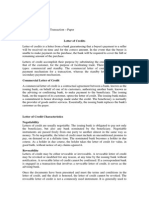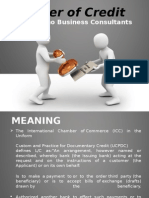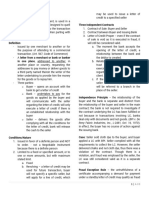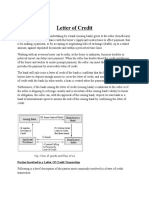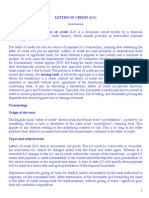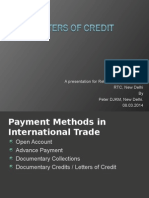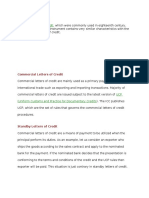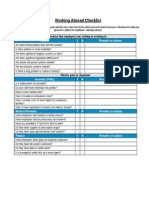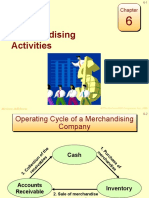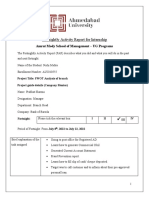K.L.N.COLLEGE OF ENGINEERING, (AUTONOMOUS), POTTAPALAYAM.
DEPARTMENT of MANAGEMENT STUDIES
International Trade Finance
Case study 1
A couple of years ago we were approached by one of our brokers in
India, who introduced us to a local contractor who had just been
awarded a contract for a residence building project in the state of
Tamil Nadu, India.
At that time, the contactor’s business was operating for several years,
slowly but steadily growing. Being awarded the project gave the
contractor both comfort and stress. It was his biggest contract yet and
knowing should everything go smoothly, he could expend his business
and go on a path to financial relief.
He faced his first obstacle looking to buy raw materials to be used for
the project, particularly medium dense fibre boards. At these scales of
materials in need of use, our contractor had to find a competitive price
that will keep his margins wide enough, so for the first time he set up
to buy the fibre boards from a supplier outside India.
Since goods had to be shipped from country to country, our team of
trade finance specialists advised our client to open up a documentary
letter of credit on his behalf. A documentary letter of credit is a
document, usually issued from a bank that assures the supplier that
they will receipt payment up to the amount of the letter of credit, as
long as certain documentary conditions have been met.
One of these conditions is the shipment of goods by the supplier,
keeping our client’s mind in peace knowing there is no chance he will
pay for the goods but the supplier won’t ship them. Another advantage
for our client was him having the bank act on his behalf, saving him
valuable time he needed to put into his operation.
Because this was our client’s biggest project at that time, we wanted
to help him keep his cash-flow at a level that will keep him operating,
and if needed avert resources to other projects. One of the conditions
|
S.P.Nandhini AP/MBA , KLNCE
�of the documentary letter of credit was a deferred payment of 60 days
from the bill of lading date, meaning our client didn’t have to pay the
money upfront.
The contractor also needed to make sure he is keeping up with the
project’s schedule. The issuance of a documentary letter of credit sets
a very specific timeline for the process of shipment and payment of
the goods, hence assisting our client in planning ahead.
After the issuance of the letter of credit via an MT700 SWIFT message
to the supplier’s bank, the schedule was executed exactly as planned;
our client received the goods within the timeframe stipulated in the
credit, helping him finish the project according to its schedule. We
have since opened several letters of credit on our client’s behalf,
helping him grow his business even more, while maximizing his cash-
flow and capital
Case study -2
Article Two of the Uniform Commercial Practice (“UCP”) 600 defines
“Confirmation” as a definite undertaking of the confirming bank, in
addition to that of the issuing bank, to honor or negotiate a complying
presentation. This article defines a “Confirming Bank” as any bank
that adds its confirmation to a letter of credit upon the issuing bank’s
authorization or request.
In its simplest terms, a confirmed Letter of Credit (“LC”) can be
defined as a second guarantee by the confirming bank. The primary
guarantee is made by the issuing bank which commits to pay the
beneficiary of the Letter of Credit upon fulfillment of its terms. In
fact, the very nature of an LC is that it is a guarantee by the issuing
bank that payment will be made regardless of the financial ability of
the applicant to pay. By adding its confirmation, the confirming bank
is providing an additional guarantee that assures the beneficiary that
payment will be made regardless of the issuing bank’s ability to pay.
|
S.P.Nandhini AP/MBA , KLNCE
�In all cases, payments made under letters of credit are conditioned
upon the terms described within the instrument. Only presentations
that comply with the terms of the LC are considered “complying
presentation[s]” for the purposes of UCP 600. If any of the terms are
not fulfilled, neither the issuing bank nor the confirming bank are
obligated to pay unless the applicant agrees to waive discrepancies
and has sufficient credit or cash lines to effect payment.
Normally, when a letter of credit is issued, the issuing bank assumes
the risk of honoring payment upon receipt of a complying presentation.
. Unless otherwise specified, a standard letter of credit is treated as
unconfirmed by default. However, sometimes the the parties to the LC
are not satisfied with the adequacy of the issuing bank’s guarantee
and/or they are uncomfortable with the country where the issuing bank
is situated (typically because of high political or economic
insecurity). In such cases, a confirmed letter of credit is often
requested.
With a confirmed Letter of Credit, another bank, the “Confirming
Bank”, usually sited in the same country that the beneficiary of the LC
is located, will add its own “confirmation” to LC. By adding its
confirmation, the Confirming Bank undertakes to honor the
beneficiary’s claim under the instrument, provided that such
beneficiary has complied with all terms and conditions of the
particular Letter of Credit. If confirmation is added, the credit should
be made available with the Confirming Bank for honor /negotiation.
This allows the confirming bank to make payment prior to the issuing
bank’s effecting of payment.
Case study -3
In a standard Letter of Credit (“LC”), the applicant requests their bank
to issue a conditional promise of payment to the LC beneficiary.
Typically, the LC applicant is the party seeking to purchase goods
while the LC beneficiary is the seller of those goods. When the LC
beneficiary is able to borrow funds by using the LC instrument as
collateral, this is called a “Red Clause Letter of Credit”.
|
S.P.Nandhini AP/MBA , KLNCE
�Letters of Credits assist the buyer and seller to any transaction
increase cash flow and mitigate risk. The buyer can often issue an LC
in lieu of leaving cash deposits with their suppliers. The buyer’s risk
is lower because their promise to pay is limited since payment under
an LC depends solely on whether the seller complies with the
specifications and instructions of the buyer. If the seller does not
comply, payment is not guaranteed.
On the other hand, the seller’s risk is reduced because payment is
assured and guaranteed by a multinational bank rather than relying
solely on the buyer’s promise to pay. In addition to securing a
guarantee of payment from a bank, the LC also gives the seller a
secured financial obligation which they can use as collateral to obtain
cash advances from their own bank. As mentioned above, when the
letter of credit allows the seller to take a cash advances “against” the
credit, the instrument is called a red clause letter of credit.
The red clause refers to language inserted into the LC by the issuing
bank which permits the bank that receives and accepts the LC on
behalf of the beneficiary (i.e. the “nominated bank”) to pay a
percentage of the value of the credit to the beneficiary. Traditionally,
since this clause appeared in bold red type the credit was named ‘red
clause’ credit.
By using a red clause LC, the LC beneficiary can request an advance
for an agreed amount from the nominated bank. Such advances are
most often intended and used to finance the manufacture or purchase
of the goods to be delivered to the LC applicant who issued the
credit. Advances given against red clause letters of credit are often
referred to as “packing credit”. Thus, one can think of the red clause
letter of credit as a financial instrument in which a buyer extends
an unsecured loan to a seller even though it is really the seller’s bank
that provides the actual cash by using the instrument as collateral to
secure the loan.
|
S.P.Nandhini AP/MBA , KLNCE
�Case study 4
A negotiable instrument is (a) a guarantee, promise, or obligation (b)
made by a specified party (c) to pay an exact amount (d) either on
demand, or at a set time. Such instruments are typically memorialized
in, and evidenced by, a document or contract which details a
promisor’s obligation to pay money without condition either on
demand or at a future date. The expression of the obligation often
includes, but does not have to, a description of how the obligation
arose and the party to whom the obligation is owed. The instrument,
and the right to collect payment on the instrument, can be transferred
by whomever has rightful, legal title to the instrument. Therefore,
while the promisor always retains the obligation to pay, person to
whom the obligation is owed may change depending on who holds the
instrument.
Rightful Possession. Rightful possession of the document containing
the promise of payment entitles the holder to receive payment
according to the terms stated therein. “Rightful possession” refers to a
“holder in due course”, which means that the possessor of the
instrument must obtain possession of the instrument by lawful means
from the promisor or from the previous rightful possessor. Obtaining a
negotiable instrument through theft or fraud, for example, does not
give one the right to collect payment on the instrument. Conversely,
obtaining the instrument by purchasing it or receiving it as a gift from
the previous holder are examples of how one may obtain rightful
possession of the instrument, and lawful title to receive the benefits of
the obligation.
Negotiability. The word “negotiable” refers to the instrument’s ability
to be transferred (or “negotiated”) for an agreed upon value between
parties. The negotiability of the instrument arises from its
unconditional nature. Since the value of the instrument does not
depend on anything other than the value stated in the instrument, this
allows for easy valuation, which makes the instrument easy to
transfer. To appraise the value of a negotiable instrument, one must
assess the ability of the promisor to make payment and the likelihood
|
S.P.Nandhini AP/MBA , KLNCE
�that they will deliver on their promise. However, if the instrument were
conditioned upon the occurrence of other events, the value of the
instrument would have to account for the likelihood that those events
will occur. Thus, the unconditional nature of the obligation to pay
specified in a negotiable instrument allows for easy valuation and
transferability.
Transferring the Instrument. The instrument may be transferred (or
“negotiated”) to a third party when the holder of the instrument
endorses and hands it over to the purchasing (or “discounting”) party.
The final holder of the instrument will ultimately get paid by the party
obligated to pay on the instrument. Transfers can happen at less than
the face value of the instrument and this is known as discounting,
which may happen if there is doubt about the payer’s ability to pay.
Examples of Negotiable Instruments. Common examples of negotiable
instruments include promissory notes, bills of exchange (also known
as drafts) and checks. The most commonly encountered instruments
in export / import transactions are bills of exchange and promissory
notes. While bills of exchange or drafts are the most frequently
encountered negotiable instruments used in international trade
transactions, promissory notes are also commonly used.
While different categories of negotiable instruments vary in their form,
their core features are essentially the same throughout. A promissory
note contains a written promise by one party to pay another party a
definite sum of money either on demand or at a specified future date.
A promissory note typically contains all the terms pertaining to the
indebtedness by the issuer or maker to the note’s payee, such as the
amount, interest rate, maturity date, date and place of issuance, and
issuer’s signature. By contrast, a check simply states an amount that
can be drawn, typically from a bank institution. When a check is
endorsed to someone, that person becomes a holder in due course and
obtains legal title to collect or draw the amount stated in the check.
All of the above examples are independent payment undertakings that
can be transferred from one person to another.
|
S.P.Nandhini AP/MBA , KLNCE
�Governing Law. In the most countries, negotiable instruments are
ruled by legal norms specific to the country. In the United States, most
states have adopted the Uniform Commercial Code, which defines
negotiable instruments and other payment schemes and methods
commonly used in the course of routine business and commercial
transactions
Case study -5
Documents presented for payment against an issued Letter of Credit
(“LC” or “credit”) are examined against the terms and conditions of the
issued LC, as well as the UCP600 and ISBP, Publication No. 745.
Since the issuer of the LC should be able to understand the docs which
are presented, they usually require that presented documents be
submitted in the official language of the country in which the issuer is
located.
The primary governing regulations for LCs, the UCP 600 is absolutely
silent on the issue of language. However, the ISBP, Publication No.
745, offers guidance: When a credit stipulates the language of the
documents to be presented, the data and documents required by the
credit (i.e. the LC) or UCP 600 must be presented in the specified
language. When a credit is silent with respect to the language of the
documents to be presented, the documents may be issued in any
language.
When a credit allows two or more acceptable languages, a confirming
bank or a nominated bank acting on its nomination may restrict the
number of acceptable languages as a condition of its engagement in
the credit. In such cases, the required documents must be presented
in the acceptable language(s).
When a credit allows for presented document to contain data in two or
more languages and a confirming bank or a nominated bank acting on
its nomination does not restrict the language(s) as a condition of its
|
S.P.Nandhini AP/MBA , KLNCE
�engagement in the credit, the bank must examine the documents in all
of the acceptable languages appearing in the presentation. For
example, if a credit allows for documents to be presented in Spanish
and English and such documents are presented in both languages,
then the bank must check all documents and any discrepancies in
either language will cause a discrepancy in the entire presentation.
Banks are not required to examine information in documents that have
been inserted in a language that is not mandated or allowed in the
credit. The paragraphs above the name of a person or entity, any
stamps, legalization, endorsements or similar, and the pre-printed text
shown on a document, such as, but not limited to, field headings, may
be in a language other than that required in the credit without causing
discrepancies. Otherwise, relevant portions of text in a document
that are not presented in an acceptable language may cause
discrepancies, so LC beneficiaries should be careful when making
such presentations.
|
S.P.Nandhini AP/MBA , KLNCE






